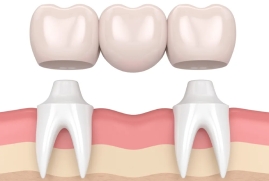
Dental Bridges are used to replace missing teeth. They can replace one tooth or even a row of missing teeth aimed at Restoring chewing function, Enhancing your appearance, and Improving oral health. As the name implies, this appliance “bridges the gaps” in your smile. It consists of Crowns (that fit over your adjacent natural teeth) and Artificial Teeth (that fill in the gaps in your smile).
A Dental Bridge consists of two parts that make up the unit, namely:
1. Abutments – These are structures that provide support to your dental bridge. Generally, natural teeth act as abutments, but in some cases, they also refer to tiny connector posts used in dental implant-supported bridges.
2. Pontics – These are artificial or false teeth fitted into the gap left behind by missing teeth.
The number of Abutments and Pontics in a bridge is variable and dependent upon the individual’s oral condition. This makes every bridge personalized to the treatment needs.
When is a Dental Bridge Required?
As mentioned above, Dental Bridges are used for replacing one or more than one tooth. But not everyone is a good candidate for getting a Dental Bridge. Initial oral examination along with radiographs help your dentist determine if a bridge would be beneficial for you.
Factors that make one a good candidate for dental bridges include:
- Missing one or more Permanent Teeth
- Having no serious medical conditions, infections, or any other health problems
- Healthy surrounding teeth with a strong bone structure to support the bridge
- Good Oral Health Status
- Has dexterity to perform oral hygiene practices to maintain the condition of the dental bridge
Taking into consideration your oral health needs along with the following factors help your dentist decide what type of bridge would work for you:
- Age (Bridges aren’t generally Placed in Children)
- Number of Missing Tooth
- Size of the Gap
- Adjacent Tooth Condition
- Whether a Natural Tooth is present on either side of the gap
Wondering if a dental bridge is right for you? Consult our prosthodontists near you for a personalized evaluation.
Book an Appointment
Dental Bridge Types
At Clove Dental, there are four types of Dental Bridges available that are suitable for different oral conditions.
1. Traditional Dental Bridge
A Traditional Dental Bridge consists of a false tooth or series of teeth being held in its place by dental crowns cemented onto abutment teeth on either side.
This is the most popular type of dental bridge used. Widely used in cases when there are healthy natural teeth on both sides of the missing tooth gap.
2. Cantilever Dental Bridge
The design is almost similar to that of a traditional dental bridge, but there’s support taken from only one end, not both. The bridge is bonded over to the crown on one end and on the other side, the Artificial Teeth hangs/extends over the Gap.
It is generally used in cases where natural teeth are present only on one side of the gap. Due to their design, cantilever bridges do not tend to be as strong as traditional braces.
3. Maryland Dental Bridge
Maryland Dental Bridges are also known as resin-bonded bridges. They use metal wings instead of crowns to secure the bridge in place. The wings are bonded to the back of your neighboring teeth.
Given their design, they aren’t strong enough to withstand the chewing forces of back teeth, hence used to replace front teeth.
4. Implant-Supported Bridge
The difference between a traditional bridge and implant supported bridge tends to be its supporting structure. While traditional bridges gain support from adjacent teeth, implant supported bridge rests atop dental implant. These dental implants have small threaded posts that act as replacements for missing teeth roots.
Dentists generally recommend Implant supported dentures when there are three or more missing teeth in a row.
Dental Bridge Cost
The cost of dental bridges is variable and is affected by the following factors:
- Number of teeth needed to fill the gap
- Material used for fabrication, such as composite resin, zirconia or metal alloy covered in resin
- Complexity / Difficulty of Placement
- Additional treatments are required for other dental issues, such as gum diseases
The prices offered by Clove Dental for some of the most popular dental bridge designs are as follows:

Metal Bridge
Starting ₹6,580
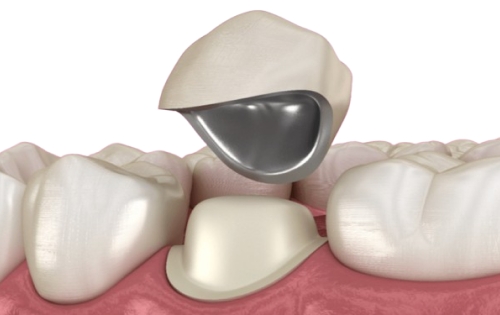
PFM Bridge
Starting ₹8,780
Book an Appointment
Dental Bridges v/s Implants
| Aspect |
Implant
|
Bridge
|
| Procedure |
Planting inside the bone of the missing site |
Shaving down both adjacent teeth and making three teeth into one mass to fill the gap |
| Tooth Damage |
No damage to adjacent teeth |
Need to shave down healthy adjacent teeth |
| Treatment Period |
3-6 months |
Short |
| Treatment Cost |
Expensive at initial cost, but economical in the long run |
Inexpensive |
| Masticatory Force |
Same masticatory as natural tooth |
Weak masticatory force due to the absence of dental root |
| Lifespan |
Semipermanent lifespan |
Replacement every 5-10 years |
Dental Bridge Procedure
The basic procedure of placing a bridge involves placing a crown on teeth on either side of the gap. These supporting crowns are joined together by another crown that acts as a false tooth to fill in the gap of missing teeth.
The procedure of getting bridges is multi-stepped so involves multiple dental visits.
- Initially, your dentist will do a thorough oral examination, using clinical methods as well as radiographs.
- If any tooth decay or gum diseases are to be seen, the primary step would be to treat them.
- Your surrounding teeth and mouth will be now measured and checked to ensure that the teeth are strong enough to support bridges.
- Depending upon the design chosen for the bridge, either one or both teeth on either side are filed to prepare for the dental bridge. An impression will be taken, out of which a mould will be created for the fabrication of the bridge
- A temporary bridge might be given while you wait for a permanent bridge, to support and protect the tooth structures.
- Final step involves using dental cement for fixing the permanent bridge into its place.
Dental Bridge Benefits & Risks
Dental bridges offer many benefits. But they also come with their own set of drawbacks too:
ADVANTAGES
- Offer a natural-looking solution for Tooth Loss
- Restore Chewing and speech function (missing teeth make it difficult to eat or speak properly
- Prevents drifting of teeth into the space left behind by missing teeth
DISADVANTAGES
- If there is any damage or trauma to your abutment teeth, it also weakens your dental bridge
- If the abutment teeth aren’t strong enough to be able to support your bridge, they tend to fracture easily
- If proper oral hygiene isn’t maintained, it leads to gum inflammation or cavities
How to Care for Your Dental Bridges
You can ensure increased longevity of your bridge by taking good care of it. Some of the steps you should follow to assure the well-being of your dental bridge are:
- Regular Dental Checkups for Assessment and Cleanings
- Brushing your teeth twice daily and making floss your best friend
- Using Threaded Floss and small brushes to clean between teeth
- Staying away from hard or very chewy food
- Don’t chew on items that might damage your teeth
- Try using a Non-Abrasive Fluoride Toothpaste
Don’t ignore these signs and visit your dentist as soon as you have any of these problems:
- Your bridge is loose or cracked
- It hurts upon chewing
- Your teeth have become sensitive, or your gums feel sore or are bleeding
Google Reviews
Dr Dinesh, Dr Shilpa, Dr Kalpana, excellent support & follow ups. Very happy with my treatment here.
Multiple treatments including RCT and bridge were handled with utmost care at Clove Dental. Dr. Nikita explained everything clearly, and Dr. Zubair did a great RCT. Truly professional and gentle.
Extensive treatment including crowns, bridges, and implants was expertly managed by Dr. Sushma Yadav and team at Clove Dwarka. Truly professional, transparent, and trustworthy.
Frequently Asked Questions
1. What problems could develop with Dental Bridges?
Common problems that develop with Dental bridges:
- Ill-fitted bridge
- Increased levels of tooth sensitivity
- Tooth Decay
- Damage to anchoring tooth
- Damage to the dental bridge itself
2. How long will a Dental Bridge last?
A dental bridge easily lasts 5-15 years before the need for replacement. You can help it last by taking good care of it.
3. Do I need to undergo root canal treatment for placement of the crown?
It is not always necessary to get a root canal treatment done when getting a crown. But this depends upon the extent of tooth damage.
4. What are alternatives to Dental Bridges?
Dentures (removable or fixed) and Implants(fixed) are two other common prosthetics used to replace missing teeth.
5. Is Dental Bridge Painful?
No, getting a bridge doesn’t hurt. There might be some discomfort during the initial adjustment phase, but not pain. Your dentist numbs your mouth for the parts of the procedure that might be painful.
6. What are the Pros and Cons of Dental Bridges?
Pros:
- Offers a Natural-looking Replacement for Missing Teeth
- Helps to restore proper chewing and speech function
- Prevents shifting around of surrounding teeth
Cons:
- The success rate is dependent upon the health of supporting (abutment) teeth
- There is a risk of fracture if abutment teeth are weak
- Requires diligent oral hygiene to prevent gum disease and cavities
7. What is the best Dental Bridge Material?
Porcelain fused to Zirconia and Pure Porcelain are commonly used materials for dental bridges.
8. Will my Dental Bridge Look Natural?
Dental Bridges aims to offer a natural-looking solution for tooth loss.
9. How many appointments does it take?
Dental bridge takes two visits to prepare and fit. It includes preparing the abutment teeth, fabricating restoration and placing of the bridge.
10. Is it possible to get a cavity under a bridge?
With compromised oral hygiene, there is a possibility of cavity development under a bridge
11. How many Crowns are on a Bridge?
They have two crowns – one on either end – and a bridge of replacement teeth that rest in the area of the gums where there is tooth loss.
12. Is a tooth bridge permanent?
The average lifespan of a bridge is 5 to 15 years. They are permanent in the sense that only a dentist can remove them.
13. What is the cost of a 3 tooth bridge in India?
At Clove Dental, the starting price for a metal bridge is Rs. 6580 and for a PFM bridge is Rs. 8780.
 Medically Reviewed
Medically Reviewed
Last Reviewed by Clove Clinical Team on Aug 04, 2024 | Written by Dr. Shreya Singh
Learn more about Dental Bridges
Also, learn more about all available dental specialties and treatments at Clove Dental here.
People who viewed this page also visited




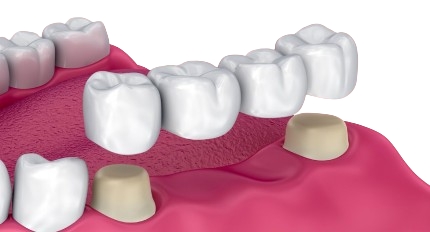
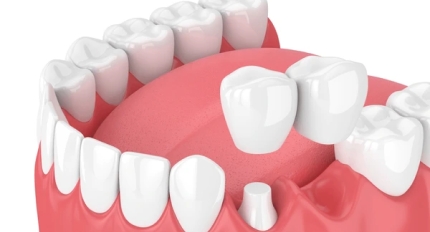
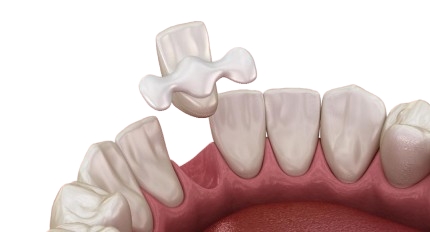
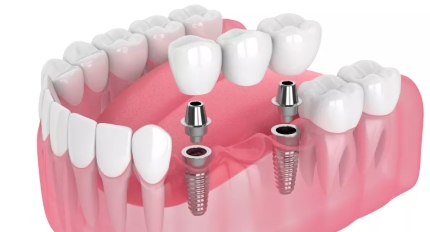




 Call us: 9393553232
Call us: 9393553232